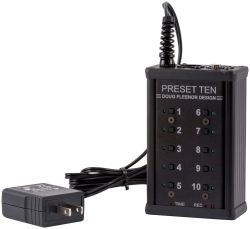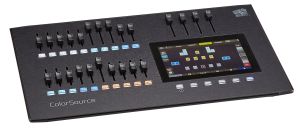Last time, we began our journey into Lighting 101 with a discussion on DMX and how most modern lighting equipment sends or receives lighting control using this communication protocol. We didn't get into what sends that communication to lighting fixtures, controllers, and this is the topic for today's Worship Tools Newsletter. Controllers come in all shapes, sizes and budgets, from simple push button preset controller to full blown moving light controllers that can handle dozens of DMX 512 universes. Whatever your lighting controller needs are, there is an option that will make sense for you.
Preset Controller

The most basic of DMX controllers, a Preset Controller, simply allows you to create a certain number of preset looks with another lighting controller and save them to preset buttons on the controller. For example, the Doug Fleenor Designs Preset 10 Controller is a super simple way to give someone 10 preset lighting looks to choose from. Particularly useful when you only use standard looks all of the time, Preset Controllers can make lighting easy for children's or youth rooms. They also work great as a secondary controller in your main auditorium, offering a variety of looks for weddings, funerals and special events. While they offer super simple operation, the drawbacks with Preset Controllers are that they are typically limited to what is on a single universe of DMX. You need to use another controller to set it up and you are then limited to the presets you created, as you created them, unless you have another controller in line.
Fader Based Controller

The old school method for controlling lights, fader-based controllers, were simple because most every light had a fader and when you pushed it up to a certain percentage, the light(s) on that fader turned on to that percentage. And many fader-based controllers also allowed you to create looks and save them to a fader preset, allowing you to fade in or out of a preset look. The ETC Smartfade is an excellent example of a fader-based controller and is still a great console to use when you have a smaller, fairly simple lighting rig. If you have 12 conventional white lights and 6 LEDs, 12 faders would most likely be taken up with the 12 conventional fixtures, while the LED's would be grouped and then addressed into an RGB mode. In other words, for every LED addressed to 13, fader 13 would increase/decrease red, 14 would adjust green and 15 would adjust blue. It's not necessarily the most powerful way to control multi-function lighting fixtures (like LED or moving lights), but for a small rig something like the ETC Smartfade 1248 can still be very functional and effective.
Small Format Hybrid Controller

With more and more venues turning to LED lighting, some manufacturers have developed controllers that look to expand the capability of fader-based controllers without getting into the complexity of full function controllers. For example, the ETC COLORSOURCE console offers the ability to run a large number of LED lighting fixtures in cues and playbacks as well as a multi-touch screen for control and color adjustment. While limited in the quantity of fixtures and groups you can work with, for many churches this hybrid controller mentality will be the perfect blend of capability and simplicity.
Full-Function Lighting Controller
For lighting rigs that have a lot of fixtures or a variety of types of multi-function (or intelligent) fixtures, full function lighting controllers become critical to organizing, programming and executing complex lighting looks and programs. Each featuring a built-in operating system running proprietary control software, brands like ETC, Jands Vista, High End Systems and Grand MA are just some of the major players in this category. These types of controllers are typically larger and feature-packed with the capability of controlling up to dozens of universes of lighting fixtures no matter how complex the fixtures are. You'll find these types of full feature controllers on most tours as well as in most larger facilities, especially where complex programming is involved. Beginning in the low $10's of thousands and going up from there, these controllers pack a punch and a hefty price tag.
Full-Function Computer Based Controller

For those who need full programming functionality without the high quantity of fixtures or faders, manufacturers like Jands Vista and High End Systems have a step down from the full function controller where you provide a PC or Mac running their software with a smaller fader wing hooked up for playback and/or DMX output. For example, the Jands Vista S1 gives you all of the programming power of the Jands Vista L5 with less surface faders, no touch screen and you providing your own computer at roughly 1/6th the price. If you're church is like mine, with a 48-96 channels of dimming and a dozen or two LED's, a Jands Vista M1 controller with a Mac Mini may meet your needs perfectly for less than half the price of a Jands Vista S1. If you've got a big rig or are doing a high level of programming then this intermediate step probably isn't for you, but for most of us this newer category of lighting controller is making full function programming affordable.
Wrap Up
So, which console is right for you? I'd love to tell you console X is the right way to go but the answer truly is "it depends". What kind of lighting rig do you have now? What kind of lighting do you plan to add over the next 3-5 years? What kind of things do you hope to accomplish with your lighting? What kind of capability and training does your team have? These are all questions that we ask as we help you find the right console to help you meet your lighting control needs. And of course we don't stop there. Our team can help your team get the most out of your lighting controller with training from experienced lighting designers and programmers. We want your lighting rig to look and function great, and we're ready and available to help you do so at any time.
![]()